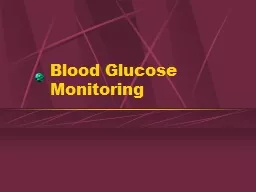

What is Glucose A simple sugar that enters the diet as part of sucrose lactose or maltose Part of a polysaccharide called dietary starch Most of the bodys energy comes from glucose Insulin effects glucose metabolism ID: 498796
Download Presentation The PPT/PDF document "Blood Glucose Monitoring" is the property of its rightful owner. Permission is granted to download and print the materials on this web site for personal, non-commercial use only, and to display it on your personal computer provided you do not modify the materials and that you retain all copyright notices contained in the materials. By downloading content from our website, you accept the terms of this agreement.
Slide1
Blood Glucose MonitoringSlide2
What is Glucose?
A simple sugar that enters the diet as part of sucrose, lactose, or maltose
Part of a polysaccharide called dietary starch
Most of the body’s energy comes from glucose
Insulin effects glucose metabolism
Insulin moves glucose into the cells
Stimulates storage of excess glucose as glycogen in the liver, or in muscle tissues Slide3
Why is it Important?
Hypoglycemia and hyperglycemia may be medical emergencies
Hyperglycemia may cause damage, dysfunction, and failure
Serious complications involve eyes, kidneys, nerves, heart, and blood vesselsSlide4
Types of Diabetes
In
Type I Diabetes
, defect in insulin secretion
Usually diagnosed when less than 30 y/o
Onset rapid, and must be treated with insulin
Type II Diabetes
, defect in insulin action, or not enough insulin produced
Usually diagnosed when over 30 y/o
Onset is gradual
May be controlled by low carbohydrate diet, oral anti-diabetic medications, or insulinSlide5
Normal Ranges
Newborn 40-60 mg/dl
Infant (up to 2 yr.) 50-80 mg/dl
Child 60-100 mg/dl
Adult 75-110 mg/dl
Older than 90 yr. 75-120 mg/dl
From Schnell, Z., Leeuwen, A.M., & Kranpitz, T.R. (2003).
Davis’s Comprehensive Handbook of Laboratory and Diagnostic Tests
. In L.B. Deitch, G. Services, & L. Collins (Eds.), Philadelphia: F.A. DavisSlide6
Nursing Guidelines
For a person with diabetes, 80-140 is generally considered WNL’s
Keeping BG fairly stable, not swinging high and low is best for preventing complications
Some clients with “brittle” diabetes are especially difficult to control
Generally, BG slightly higher than normal is safer than having frequent hypoglycemiaSlide7
Procedure for Hypoglycemia
Use the protocol of your workplace
Usually, give orange juice, or other sweet juice, and then a snack with complex carbohydrates
Usually no extra sugar is needed
Recheck abnormal BG every 15 minutes
May recheck prior to treating if results are questionable, and no symptoms seenSlide8
Hypoglycemia Treatment
Some clients may keep candy or glucose tabs with them for low BG
Facilities may have glucose gel, and Glucagon injections available
Use if clients unable to drink or eat
Need physician’s order to administerSlide9
Recommendations for Hyperglycemia
Encourage client to drink water & maintain normal activities, rather than go to sleep
Observe closely for signs of dehydration or low blood pressure, ketoacidosis or extreme sleepiness
Call physician for BG over set parameters
Call 911 for mental or neurological changes, or if unable to retain oral fluidsSlide10
Ketoacidosis
Without adequate insulin, fat breakdown occurs-attempt to provide glucose to cells
Ketone bodies are the acidic byproduct
Ketones can be found by a urine test
Causes fruity odor to the breath
Symptoms may be nausea and vomiting, abdominal pain, hyperventilation
Can result in coma and deathSlide11
Common Errors in BG Monitoring
Improper application of blood (drop too small) or site not clean and dry
Neglecting cleaning and maintenance of BG meter
Reagent strips damaged by heat or humidity
Using outdated strips
Improper calibration of meterSlide12
What Are the Symptoms of Hypoglycemia?
Headache
Confusion
Hunger
Irritability
Nervousness
Shakiness
Sweating, clammy skin
Anxiety
Weakness
Palpitations
Restlessness
Caused by too much insulin, too little food, or more activity than usualSlide13
What Are the Symptoms of Hyperglycemia?
Poldipsia (Thirst)
Polyphagia (Hunger)
Polyuria (Frequent urination)
Blurred vision
Drowsiness
Nausea
Caused by too much food, too little insulin, or metabolic stress, including illness, or some drugsSlide14
What Drugs Can Cause Hyperglycemia?
Glucocorticoids
TPN (Total Parenteral Nutrition)
Usually, BG monitoring is needed with these treatments, even if the patient is not diabetic
Beta Blockers
Phenobarbitol
Birth Control PillsSlide15
Critical Values
Hypoglycemia
less than
40 mg/dl
Intervention is needed when less than 80 in adults
Hyperglycemia
greater than
400 mg/dl
BG over 600 reads HI on most meters
Contact physician immediately after starting treatment, unless you have prior directions for thisSlide16
Why Does the Type of Insulin Matter?
The types of insulin have different onset, peak, and duration
Certain times of the day involve risk for hypoglycemia based on type of insulin, and timing of insulin and meals
Frequent BG monitoring is especially important with new diagnosis, or with insulin dose adjustmentsSlide17
Insulin Summary
Insulin
Form
Onset
Peak
Duration
Rapid Acting
Lispro
Humalog
Less than 15 min
½ to
1 ½ hours
2-4 hours
Short Acting
Humulin R
Novolin R
Iletin II Reg
½-1 hr
½-2 hr
2-3 hr
3-4 hr
3-6 hours
4-6 hours
Intermediate Acting
Humulin or Novolin L (Lente) or NPH, or Iletin II NPH
3-4 hr
2-4 hr
4-6 hr
4-12 hr
4-10 hr
8-14 hr
12-18 hr
10-16 hr
16-20 hrSlide18
Insulin Summary (Continued)
Insulin
Form
Onset
Peak
Duration
Long Acting
Humulin U (Ultralente)
Lantus (Glargaine)
6-10 hr
1.1 hr
No peak
18-20 hr
24 hours
Insulin Mixtures
Humulin or Novolin 50/50
Humulin or Novolin 70/30
Contains 50% NPH and 50% Reg
70% NPH and 30% Reg
Taken from table developed by Barb Puryear, RN, MSN, NP. (2004). Western Wisconsin Technical College, LaCrosse, WISlide19
Conclusion
Knowledge and skills for Blood Glucose monitoring are essential for nurses
Role includes teaching clients self-monitoring and diabetic management
Prompt response to abnormal readings can prevent serious medical emergencies and diabetic complicationsSlide20
This presentation was created by Mary Knutson, RN
January, 2005